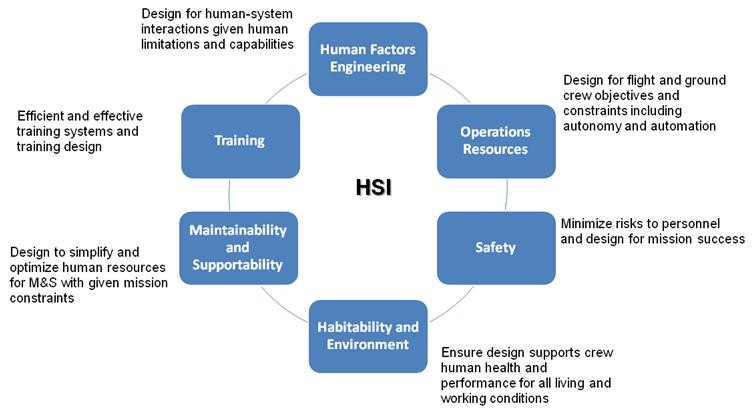First Annual Human Systems Integration Workshop a Success
The Human Systems Integration (HSI) Employee Resource Group (ERG) hosted its first annual HSI Workshop on April 9. Per the NASA/SP-2015-3709, HSI Practitioner’s Guide, HSI encompasses “interdisciplinary technical and management processes for integrating human system considerations and performance objectives within and across all system elements; an essential enabler to systems engineering practice, safety, health practice toward optimal mission execution, and reduced total system life-cycle costs.”
The workshop had two main goals: 1) Learn the state of HSI at NASA’s Johnson Space Center (lessons learned and current/future efforts); and 2) Identify how the six NASA HSI domains (Figure 1) can be applied in a mission. For the second goal, the Gateway Program was used as a case study to allow participants to practice identifying hypothetical HSI requirements, as well as verification and validation methods.
Seventy-two presenters and attendees from approximately 20 organizations at Johnson, along with representatives from NASA Headquarters, Ames Research Center and Langley Research Center, attended. Participants’ HSI experiences ranged from novice to expert, but all had an interest in learning and sharing their knowledge. Among the participants were founders and longtime members of the ERG, such as Jennifer Rochlis, George Salazar, Christie Sauers and Doug Wong.

Figure 1. NASA’s HSI domains.
Opening remarks from HSI ERG Chair Jackelynne Silva-Martinez highlighted the notion that humans, along with their capabilities and limitations, are part of the systems that they interface with. While the end user (crew) is critical, “humans” includes all personnel who are involved in a given system. Even with automated systems, humans need to be considered, because they code these systems and troubleshoot them if issues arise.
Throughout the day, participants learned about how HSI has/is/will be applied during the life-cycle of NASA systems (e.g., ISS, Orion, Gateway, xEMU, aircraft). Participants were also educated about various risks and lessons learned associated with not incorporating HSI throughout the life-cycle of systems. For example, Dennis Pate, a Human Factors Engineer with Safety & Mission Assurance experience, discussed in his presentation how HSI and human factors issues may have contributed to significant incidents in human space flight. He also highlighted the need for NASA to capture corporate knowledge and lessons learned and utilize this information in the future.
Morning keynote speaker Dr. Vincent Michaud, deputy chief health and medical officer at NASA Headquarters, explained that there is an agencywide push for HSI given that NASA is entering an unprecedented period of development and design with various pieces of hardware and vehicles being made around the country. For example, afternoon keynote speaker Debra Ludban, Gateway vehicle systems integration deputy manager, discussed NASA’s new mission to go to the Moon via Gateway and some of the HSI work currently being done.
Michaud emphasized that “considering HSI early in the design cycle avoids costs late in the design cycle, when you can least afford it,” and that NASA needs to “[develop] a culture that embraces HSI so that every engineer is thinking about HSI from the first minute, not when … attaching humans to something. That’s too late.” Michaud also stated that “HSI gives us a toolset to keep costs down and schedules under control.”
Other presenters echoed these sentiments. Bill Othon, Gateway test and verification manager, indicated that with “the fleet of new vehicles coming up … HSI has to get involved early.”
Ginger Kerrick, chief of the Flight Integration Division, discussed how she encourages her employees to “get involved early in design process, because that is where you can affect the most change,” and to “think about how to simplify design early on [because it is a] pretty good cost trade in the grand scheme.”
Workshop participants also learned about and discussed the state of the HSI ERG. In particular, the group had conversations about whether the ERG should be replaced by a Community of Practice, or if both should be present at the center.
Johnson Chief Scientist Eileen Stansbery, deputy director of the Exploration Integration and Science Directorate and the HSI ERG co-executive sponsor, discussed advantages and limitations of ERGs and Communities of Practice. “A Community of Practice … can have broader inclusion within a community, which includes both employees and mid-level managers, which have an interest in or are stakeholders in the field. ERGs can take interested [individuals] that may not be practitioners of that discipline, but Communities of Practice are typically only practitioners. ERGs have broader reach ability. To have both at JSC is a value … [We] need to take advantage of the differences.”
The workshop culminated with participants putting into practice the HSI concepts they learned throughout the day by splitting into one of six working groups (each representing one of the six NASA HSI domains). Each group ran a learning exercise to formulate big-picture requirements and possible verification and validation methods given some Gateway assumptions. Then, each group presented their findings to the entire group.
The 2019 HSI ERG Executive Board would like to thank all of the HSI workshop supporters (attendees, presenters, volunteers, sponsors, etc.) that made the event a success. Please visit the ERG’s SharePoint and join the listserv to learn more about HSI and stay current about upcoming events and opportunities.
The HSI workshop presentations were recorded and will be available via the HSI ERG SharePoint site at a later date. Images from the event are available for download here.










